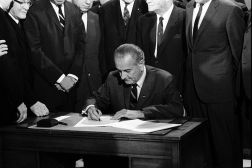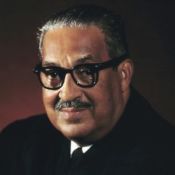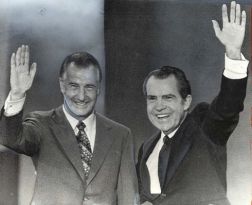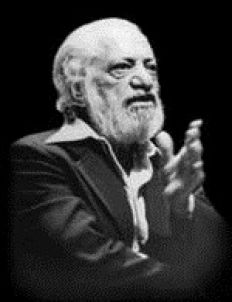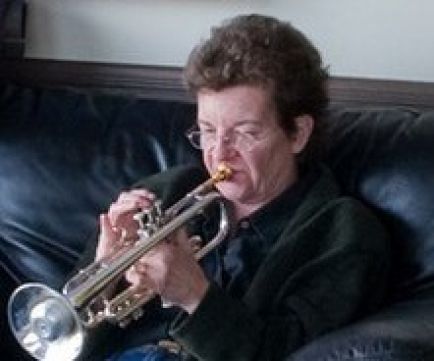
|
Laurie Frink (1951 - 2013) Pioneer Trumpeter and Inspirational Brass Teacher | 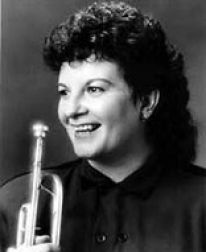  |
Hear Laurie lead the trumpet section in the Maria Schneider Band (Maria Schneider's arrangement of Giant Steps) |
|
Forget piano, I want to play trumpet! |
1951 Prices and People |
The tiny farm community of Pender, Nebraska (pop. 1,000) seems like an unlikely place to spawn a world-reknown trumpeter, but that's where Laurie Frink was born and raised. Her father, James Frink, was a candy salesman. Her mother, Carol Frink, was a homemaker. The family had no records and didn't listen to music, but Laurie's mother made her take piano lessons. Laurie loved music but she hated playing piano. She wanted to play in the school band. Her mother agreed to let her quit piano if she chose another another instrument to study. “I picked the trumpet, because it was shiny,” Laurie later said. She didn't know much about the instrument, only that “it was like a bugle.” [1] There wasn't much to do in Pender so Laurie spent a lot of time practicing and soon became a fine trumpet player. She graduated from high school in 1969. Seeking more advanced instruction, she applied for admission to the University of Nebraska in Lincoln, 100 miles south of Pender. | Bread $0.16/loaf. Milk: $0.92/gal. average car, $1,800; a house, $16,000 Average income: $4,194/year Minimum wage: $0.75/hour Harry S. Truman was President of the United States Les Paul & Mary Ford had a hit record: How High the Moon A musical, An American in Paris, won Best Picture Oscar; Best Actress: Vivien Leigh, A Streetcar Named Desire. Lucille Ball (one of the first women to have her own TV show) starred in I Love Lucy with her Cuban bandleader husband, Desi Arnez.
|
Obstacles, Inspirations and Challenges
|
Laurie wanted to major in performance, but UNL didn't allow female students to do that. Her only option was to major in music education. Of the school's 40 trumpet majors, Laurie was the only female. No women played in the UNL marching band or jazz band. [1] |
Laurie's trumpet teacher, Dennis Schneider, played principal trumpet in the Lincoln Symphony Orchestra. He was also the UNL jazz band director. Recognizing Laurie's talent, he invited her to play in the jazz band. Photo right (1972) courtesy of Don Gorder, now Music Business Dept Chair at Berklee College of Music. In the trumpet section, Laurie is in the black shirt; Don Gorder to her right in the purple shirt. Seated center, UNL jazz band director Dennis Schneider |   |
During the summer of 1971, Laurie attended the Aspen Music Festival in Colorado. Although her UNL training was as a classical player, she wound up in the jazz band and loved it. At the end of the summer, jazz trumpeter Jimmy Maxwell (photo at right) played with the band as a guest artist. “I had never heard a trumpet like that before,” she later said. “I knew that was what I wanted to do.” | 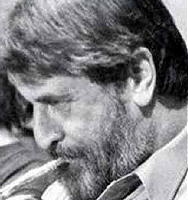  |
She returned to UNL, but began traveling to New York City to study with Carmine Caruso, (photo right) known around the world to professional brass players. Although Caruso was a saxophonist, his teaching style, The Carmine Caruso Method, derived from the unique exercises he devised, emphasizing mastery of the physical aspects of playing to give his students confidence in their ability to play in any style. |   |
A Brutal Gig | |
In 1972, the Ringling Bros. Circus came to Omaha. Laurie and Don Gorder, her UNL jazz band colleague, were hired to split the lead trumpet book. Playing the circus is brutal, two shows a day and three on Saturday. The shows are three hours long, three hours of high, loud and fast playing for the trumpets. Six months earlier Don had undergone an appendectomy. During the third show on Saturday he felt a stabbing pain. Fearing he'd torn the incision, he told the conductor he was in pain. The conductor told him to go rest for a while, leaving Laurie to play the lead book by herself. Eventually Don returned to the band and resumed playing. The moment the show was over Laurie put down her trumpet and vomited. Even then she did whatever it took to play the gig. [2} |   |
After graduating from UNL in 1973, Laurie told her parents she wanted to move to New York City and study with Jimmy Maxwell. Her parents said no. Undeterred, Laurie packed her things and left. |
1967 - 1972: Racial Strife, Assassinations, and Political Scandals |
During Laurie's high school and college years, the United States endured tumultuous times. President Lyndon B. Johnson signed The Civil Rights Act into law in 1964 (photo right). The law outlawed discrimination based on race, color, religion, sex, or national origin. But racial strife continued. In 1967, there were race riots in Tampa, FL, and Buffalo, NY. |
|
However, that year the US Supreme Court unanimously ended laws prohibiting racial intermarriage, and Thurgood Marshall (photo below left) became the first African-American US Supreme Court justice. | Ironically, two films with racial overtones won Oscars in 1967. In the Heat of the Night won the Best Picture Oscar. Katherine Hepburn won Best Actress for Guess Who's Coming To Dinner. Sydney Poitier (photo left) starred in both films, but won no award |
The most well-known female musicians were singers, not trumpet players. |
Barbra Streisand performed in Central Park (photo right). |
| “Respect” by Aretha Franklin (photo right) hit #1 on the charts. |
|
| On April 4, 1968, civil rights leader Martin Luther King, Jr. was assassinated in Memphis. | On June 5, 1968, US Senator Robert F. Kennedy was assassinated in Los Angeles, after winning the California presidential primary. |
|
In 1970, the Beatles split up. In 1971 Paul McCartney formed his own group, Wings. That year, It's Too Late, by singer-songwriter-pianist Carole King was a big hit. Mary Tyler Moore and Carol Burnett starred in their own TV shows. |
In 1972, Richard Nixon was reelected President.(right in photo) Spiro Agnew (on the left) was his Vice President. But Agnew was forced to resign in 1973 after pleading no contest to charges of tax evasion. House Minority Leader Gerald Ford became Nixon's Vice President. |
|
|
But Nixon had his own problems. Ever since his 1972 re-election, he had been embroiled in the Watergate break-in scandal. On August 9, 1973, Richard Nixon resigned in disgrace. Gerald Ford was sworn in as 38th President of the United States (photo above right). | ||
Trumpet lessons and a Long-term Relationship |
Laurie arrived in New York City in 1973 with no money. To support herself, she worked various menial jobs. She studied with Gerard Schwartz, Principal trumpet of the New York Philharmonic Orchestra, and jazz with Jimmy Maxwell. In 1972, Maxwell had played the haunting trumpet solo heard throughout The Godfather. “He charged me $5 a lesson when the going rate was $30,” Laurie said, “because he liked me and he thought I wanted to play.” | |
She also continued her studies with Carmine Caruso, who became her romantic partner, a relationship that lasted more than twelve years. When he died in 1987, Laurie was devastated. “[He taught you] to approach trumpet playing from a muscular standpoint … to play so that the physical didn't get in the way. Trumpet players always have trouble with their chops.” “[He] was a great psychologist. I used to watch him in the studio. Inside of one hour, he could give somebody self-confidence. He was always reassuring me that I could play. Carmine taught me that, for people who are really into music, all that matters is that you play. [1] |
|
Freelancing in New York and a Big Break |
During the 1970s Laurie was a busy New York City freelancer. She played numerous Broadway shows, Anything Goes, 42nd Street, Les Miserables, and many others. She recorded radio and television jingles, movie soundtracks, and appeared with the Talking Heads, David Bowie and David Sanborn. |
The gigs were lucrative, but Laurie preferred to play jazz. “I like the feeling and the expressiveness and the individual personality. My favorite musicians are Miles Davis, Lee Morgan, Duke Ellington, and Johnny Hodges … although I do love Ornette Coleman.” [1] |
Her big break came in the late 1970s when jazz saxophonist Gerry Mulligan decided to form a new big band. Jimmy Maxwell recommended that he hire Laurie. Mulligan was skeptical, but he had heard Marie Speziale play with the Cincinnati Symphony when he performed with them. He thought: “If one woman can play, maybe two can.” Laurie won the lead trumpet chair. Their first gig was in Cincinnati. Laurie met Marie Speziale and thanked her for paving the way. Laurie toured the world with Mulligan's band and played on his Grammy-winning album, “Walk on the Water.” [1] |
Big Bands and Bus Tours |
|
In 1986, she toured with the Benny Goodman Band (Goodman with his sax section at right). Although musicians in his earlier bands didn't always find the experience pleasant, Laurie considered it a highlight of her life. “We had standing ovations before we played a note. He knew we were his last band, and we were young and we loved the music." "He was real nice to us. He took us out to lunch after rehearsals, gave us bonuses and Christmas presents, and, if we sounded good, he gave us raises. All of us cried when he died. It was quite an experience.” [1] See the Benny Goodman Band, 1986 | 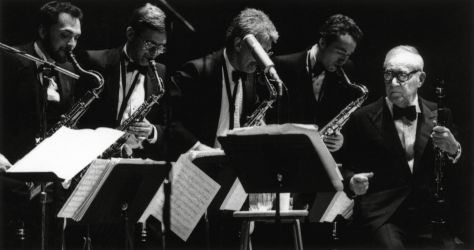  |
Laurie appears on every album by the Maria Schneider Orchestra, including two that won Grammy Awards. Photo right Maria Schneider stands in front. Laurie's face is visbile to the right of Schneider A talented composer-bandleader-pianist, Maria Schneider said, “When I wrote these subtle inner parts, I would always give them to her. I knew she was the person who would really spin the heart into the line.” [3]
During the early 1990s when Schneider was leading her big band in a Manhattan club, she considered Laurie the star of the group. | 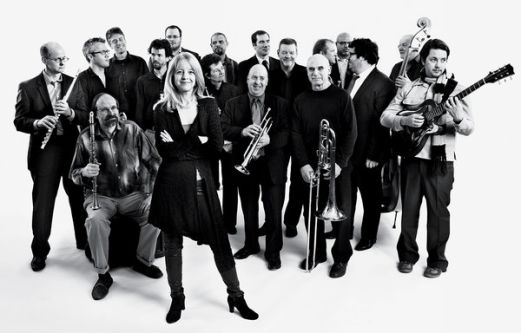  |
“She would call me after rehearsals. When she knew I was discouraged with what I'd heard, she was the one to tell me how great it sounded. She just kept so many people feeling strong and good.” [1] Schneider grew to love Laurie's dry sense of humor. “We were in Europe with the band, and we got on the wrong train to the wrong city. What a disaster. Every fuse in my being just blew. I burst into tears and Laurie came over laughing hysterically. She said, 'These are the best times! Nobody ever talks about the tours that go well.'” “That changed me for life,” Schneider says. “Whenever everything is going wrong at once, I'll think 'Oh, this is fantastic!' [Laurie] just had that way. I don't know that she was always that way for herself. She was that way for everybody else.” [4] | |
John McNeil played in the trumpet section of the David Berger Big Band with Laurie. “She was one of the best trumpet players that has ever been. She could play high notes but she wasn't just a power animal. She was one of the most accurate trumpet players I've ever heard. Just did not miss. Ever.” Recalling one recording session, McNeil said, “The trumpet section was great. Lew Soloff playing lead, me and Laurie and some other guys. Laurie had this thing that [Berger] wrote … one of these left-handed things. It wasn't impossible but it was tricky. You could miss it easily. [During the session] … we'd do a take and [someone] would screw up. Had to keep playing it over. Laurie never even came close to missing that thing. She played it perfectly every time. That sticks in my mind, the fact that she could do that. [She was] extremely dependable, and a great person to have in a band.” [4] |
|
Classical Gigs and Brass Conferences |
Thanks to her classical training, Laurie was equally versatile in orchestral and brass chamber music. She performed with the Manhattan Brass Quintet, the Saturday Brass Quintet, and the Gramercy Park Brass. She was a featured artist at the International Trumpet Competition in Kiev, Ukraine, the ITG Conference in Göteborg, Sweden, and served on the ITG Board of Directors. |
I was fortunate to spend time with Laurie at the first International Women's Brass Conference in St. Louis in 1993. At the pioneers banquet, I introduced trumpeter Leona May Smith (photo below left). Laurie introduced trombonist-composer-arranger Melba Liston (middle photo). The first night of the conference, Laurie conducted the NYC based all-woman big band, Diva, in a thrilling concert featuring works by Melba Liston (photo below right) In June 2012 the IWBC honored Laurie as a brasswoman pioneer. | ||
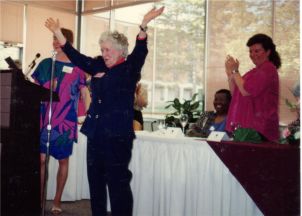  |   | 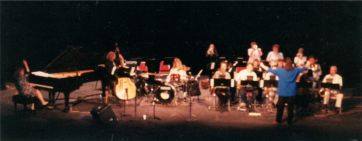  |
Left to right: Susan Fleet, Leona May Smith; Melba Liston seated, Laurie Frink standing | Melba Liston & Laurie Frink | Laurie conducts the All-woman band DIVA |
An Inspirational Teacher | |
Laurie made every group she played in sound great. But she made a lot of other brass players sound better. Her teaching brought her world-wide fame. For 25 years, she was the “go-to brass instructor" in New York City, on the faculty of New York University, the New School, the Manhattan School of Music, and the New England Conservatory in Boston. After Carmine Caruso died, she became the foremost authority on, and teacher of, the Carmine Caruso Method. [5] Brass players around the world flocked to her private studio, including many of the top jazz musicians in New York, like Dave Douglas, who said, “The one-on-one lesson with her was like a combination of therapy, gym instruction and music lesson. You'd go in thinking 'This is a disaster, I'll never be able to play the horn again'. You'd go out thinking 'I'm a champion, I love everybody, everything is going to be great.' She had a way of putting things in perspective and giving the student the power to figure out how to overcome [their difficulties].” [4] |   |
Laurie and John McNeil (quoted earlier) co-authored Flexus: Trumpet Calisthenics for the Modern Improviser (cover at right). It contains exercises and etudes from Laurie's collection, her strategies for addressing physical issues on the instrument, especially problems with embouchure and facial muscles. McNeil, who had to relearn how to play trumpet twice after a degenerative disease left him with limited muscle control, said, “If it weren't for her teaching me how to be as efficient as possible. I wouldn't be playing today. I just wouldn't be able to.” [5] |
|
Gone Too Soon | |
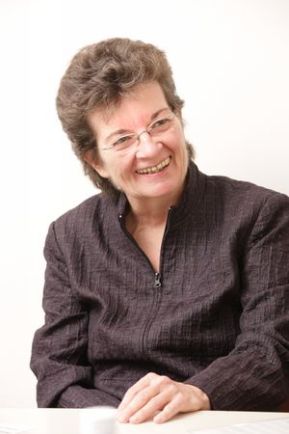  | Laurie Frink's death, from bile duct cancer, on July 13, 2013 shocked many in the music world. Classical violist Lois Martin, her partner of 25 years, said, “She worked full-time through her [illness]. She didn't want anybody to know. When she was teaching, she was teaching 100%. She didn't want any student to be worried about her." Martin says, "She had complete 100% focus for whoever was sitting in the chair across from her. Her commitment was astounding." "She would drag herself to the airport to teach [at New England Conservatory], drag herself to the hotel afterward. She did that out of the love of what she believed in. She was incredible.” [4] |
Some tributes from those who knew her Don Gorder, who played in the UNL jazz band and the Ringling Bros Circus with her, and remained friendly with her. “Laurie was an impeccable trumpeter, a gifted teacher, and an exceptional human being. She made us all glad to have known her.” [2] Ken Schaphorst, chair of NEC's Jazz Studies Dept: “One of the leading brass pedagogues of our time, Laurie will be sorely missed, as a teacher, as a player, and as a friend. I noticed immediate improvement in every NEC student who worked with her. She was also one of the most accurate and musical lead trumpet players I've ever heard.” [6] Nadje Noordhuis, a former student: “I haven't picked up the trumpet since hearing the news, and I know that moment is going to be really tough. But after I do, I will play every note as beautifully as I can, channel the grief into my ballads, help my students to better express themselves, and in true Laurie fashion, continue to do exactly as I please.” [6] | |
Perhaps the most touching tribute came from her student, Jon Crowley, who was in the audience in 2012 when the Festival of New Trumpet Music feted Laurie with a lifetime achievement award. “She sat in the back, uncomfortable with being the center of attention. … She got up at the very end when she was finally forced to talk and said: “This has been great, it's like being able to attend your own funeral and hear all the nice things people say about you!” |
If you would like to pay tribute to Laurie, please visit her new website and help honor her memory by supporting The Laurie Frink Career Grant. http://lauriefrink.com/ |
SOURCES 1. Madame Jazz, Leslie Gourse, 1995, pp 106-109 2. Telephone interview with Don Gorder, May 24, 2014. 3. New York Times obituary, Nate Chinen, July 17, 2013 4. "Remembering Laurie Frink," The Gig, a blog by Nate Chinen, July 17, 2013 5. "Remembering Laurie Frink, The 'Trumpet Mother' of the Jazz Scene," Patrick Jarenwattananon, NPR.org, July 17, 2013 6. "Trumpet-Educator Laurie Frink Dies at 61," Downbeat.com, July 29, 2013 |
© copyright 2014 Susan Fleet
Top of Page






